Dental
The British Dentists' Hospital was a late arrival on the scene. It was founded in 1911 and opened in premises in Hampstead Road.
The prime mover for the Hospital was George Thomson, an Australian dentist born in 1859, who moved to the United Kingdom in 1890. He was elected the first Chairman of the Hospital. Public health was his great passion and he spoke forcefully at meetings all over the country about the incidence of, and the fight against, dental caries. He believed loss of teeth in old age was not necessary and that the British had the worst teeth in the world; they had lost the art of mastication, preferring to suck their food than to chew it. He advocated that people should eat hard food and chew it well.
In 1912 the Hospital moved to 31 Camden Road. It was financially supported from Sunday openings of certain cinemas, otherwise patients paid according to their means. The fees received just covered expenses and made the service self-supporting.
In 1913 additional centres opened in Queens Road, Battersea (which later relocated to 23 South Side, Clapham Common), and in Lewisham High Street (which later moved to Rushey Green where, in 1914, a school dental treatment centre was also established). A dental clinic also opened in the St Pancras School for Mothers, the first such clinic for expectant and nursing mothers in Britain.
During WW1 the Hospital experienced financial and manpower problems, but increasing cooperation with local health authorities enabled mothers attending centres in St Pancras, Lewisham and Wandsworth to receive dental treatment at the Hospital's clinics. The service was later extended to Greenwich, Holborn, Fulham, Hampstead and Southwark. Local councils provided the premises and an annual grant; the Hospital provided the equipment and maintained it, and appointed dental surgeons. Special facilities for treatment were also made available at local TB dispensaries. The Camden Road clinic offered free dental treatment to men joining the Forces in 1914, claiming to be the first to do so.
In 1921 Queen Alexandra became the Hospital's Patron. She was succeeded on her death by the Duchess of York (who later became Queen Elizabeth, the Queen Mother).
The National Health Insurance Scheme, 1921, had been intended to be a stimulus for patients to seek dental treatment, but dentists were reluctant to work for the Scheme as the fees were considerably less than those approved by the British Dental Association. The bulk of the work was extractions and provision of dentures. The National Health Insurance Acts had also failed to make provision for adolescents aged between 16 and 21 to receive dental treatment (the British Dentists' Hospital offered them treatment at reduced rates).
In 1924 the Hospital was renamed the British Dental Hospital. A Samaritan Fund was set up to assist genuine cases of hardship who needed dentures.
By 1929 the Hospital had 5 centres, 8 maternity and child welfare clinics, 8 TB clinics, one Insurance Society, one full-time LCC school clinic and one special clinic for pre-school children in Battersea. The staff consisted of 39 dental surgeons (all members of the British Dental Association), 12 anaesthetists and 2 doctors.
In 1930, following the five-yearly review, a revised scale of fees was announced. The charge for a filling was 7s 6d (37p), with a maximum of 12s (60p) for any one tooth. Extractions under local anaesthesia cost 2s 6d (12p), while the fee for a 'full clearance', that is, all teeth extracted, was £1 2s 6d (£1.12). The maximum charge for upper and lower dentures was £5 10s (£5.50), reduced from £6 in 1926.
In 1931 the Hospital moved its offices and headquarters to 56 Bloomsbury Street. In March 1937 it celebrated its Jubilee by a Dinner attended by representatives of the dental and medical professions, and members of the Holborn Borough Council, presided over by Sir Norman Bennett, President of the British Dental Association.
The outbreak of WW2 caused a near cessation of work in the centres and clinics. Gradually they reopened during the daytime on a full- or part-time basis, but many of the dental and medical staff had enlisted in the Forces. The Battersea centre was bombed and destoyed, while the Lewisham centre was severely damaged and had to remain closed for a long period.
George Thomson retired as Chairman of the Executive Committee, but continued as a member of it until his death in 1945, at the age of 87. The Chairmanship of the Hospital was taken over by E.E. Turner, who had been the Honorary Treasurer since 1916, and he held both offices until his death in 1947 at the age of 73.
The Hospital did not join the NHS, but closed in 1946.
Present status (March 2010)
Most of the premises used by the Hospital have been demolished and their sites redeveloped.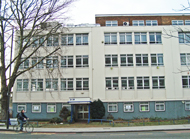
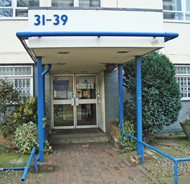
The site of the first premises of the Hospital, at 31 Camden Road.
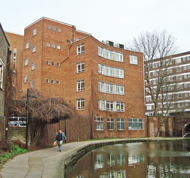
The back of the building along the Grand Union Canal.
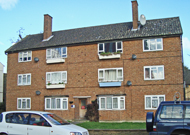
The site of the second centre at 72 Lewisham Park.

The Lewisham Park centre later moved to 46 Rushey Green. The building was destroyed by bombs during WW2. The site is now part of a Lidl supermarket.

The site of the third centre at 23 South Side, Clapham Common.

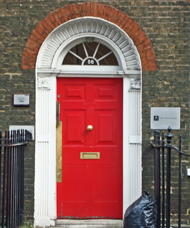
The Hospital's offices and headquarters moved from Camden Road to 56 Bloomsbury Street in 1931.
(Author unstated) 1923 British Dentists' Hospital. British Medical Journal 2 (3279), 837-838.
(Author unstated) 1945 Obituary. George Thomson. British Dental Journal 78, 27.
Spencer EM 1982 Notes on the history of dental dispensaries. Medical History 26, 47-66.
Thomson G 1911 A hospital dental service. British Dental Journal 32, 104.
www.bmj.com
www.rcpsg.ac.uk
www.rpsgb.org
Return to home page